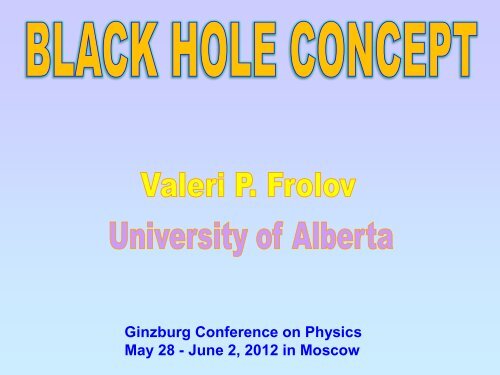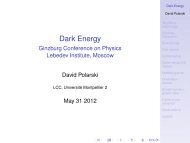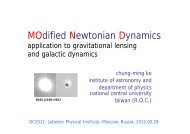Ginzburg Conference on Physics May 28 - June 2, 2012 in Moscow
Ginzburg Conference on Physics May 28 - June 2, 2012 in Moscow
Ginzburg Conference on Physics May 28 - June 2, 2012 in Moscow
- No tags were found...
You also want an ePaper? Increase the reach of your titles
YUMPU automatically turns print PDFs into web optimized ePapers that Google loves.
<str<strong>on</strong>g>G<strong>in</strong>zburg</str<strong>on</strong>g> <str<strong>on</strong>g>C<strong>on</strong>ference</str<strong>on</strong>g> <strong>on</strong> <strong>Physics</strong><strong>May</strong> <strong>28</strong> - <strong>June</strong> 2, <strong>2012</strong> <strong>in</strong> <strong>Moscow</strong>
1995: #21. “Black holes” of total 24 problems
Black hole c<strong>on</strong>cept,its evoluti<strong>on</strong>,modern status of BHs,and open problems
A black hole is a compact massive object, thegravitati<strong>on</strong>al field of which is so str<strong>on</strong>g thatnoth<strong>in</strong>g (even the light) can escape from it.The boundary of the black hole, called theevent horiz<strong>on</strong>, is a surface at which theescape velocity is equal to the velocity of light.12mv2GMmRRg2GMc2
Black hole gravity is str<strong>on</strong>g:2 2GMc2c2Rg1The E<strong>in</strong>ste<strong>in</strong>’s theory of generalrelativity is required for its descripti<strong>on</strong>
Albert E<strong>in</strong>ste<strong>in</strong>(1879--1955)Spacetime is curved. Spacetime curvature isproduced by the mass. Particles and light raysare geodesics.
GRAVITY1 8MATTERR g R T 2 c4 MATTERGGEOMETRYCAUSALITY
Karl Schwarzschild(1873--1916)In 1916 Karl Schwarzschild, an astr<strong>on</strong>omer,obta<strong>in</strong>ed a soluti<strong>on</strong> of vacuum E<strong>in</strong>ste<strong>in</strong> equati<strong>on</strong>,describ<strong>in</strong>g a spherically symmetrical static blackhole. He died so<strong>on</strong> after this.
Black Holes vs Dark Starts“Nature” ofSchw. S<strong>in</strong>gularity:Synge ‘50,F<strong>in</strong>kelste<strong>in</strong> ‘58,Fr<strong>on</strong>sdal ‘59,Szekeres ‘60,Kruskal ‘60,Novikov ’63,64
Roy Kerr(1934 --)The most general stati<strong>on</strong>ary soluti<strong>on</strong> of vacuumE<strong>in</strong>ste<strong>in</strong> equati<strong>on</strong>s describ<strong>in</strong>g an isolated blackhole was found <strong>in</strong> 1963 by Roy Kerr. It isaxisymmetric and uniquely specified by 2parameters: mass M and angular momentum J.
JohnArchibaldWheeler(1911--2008)The name "black hole" was <strong>in</strong>vented <strong>in</strong> December 1967 byJohn Archibald Wheeler. Before Wheeler, these objects wereoften referred to as "black stars“ or "frozen stars".
F<strong>in</strong>al state of stellar evoluti<strong>on</strong>:(1) White dwarf (Chandrasekhar ('31) limit 1.44 M )(2) Neutr<strong>on</strong> star (pulsars, mass limit 3 M )(Landau '32, Baade&Zwicky '34,Oppenheimer&Volkoff '39)(3) Black hole (for M 10M r 30km)g(Oppenheimer&Snyder '39)
In 60’-70’th of the past century manyremarkable results and exact theorems<strong>on</strong> the BH properties were proved.
Properties of 4D Black HolesPrice ‘72 et all“Black holes have no hair”: Mass, electriccharge and angular momentum are the <strong>on</strong>ly 3parameters which specify a stati<strong>on</strong>ary BH <strong>in</strong>E<strong>in</strong>ste<strong>in</strong>-Maxwell theory (Wheeler, 1971)
Event horiz<strong>on</strong> (BH boundary) is almost everywherenull surface (Penrose, ‘68)Black hole surface topology is (Hawk<strong>in</strong>g, ‘72 )Its surface area never decreases (Hawk<strong>in</strong>g,’71,72)So<strong>on</strong> after their formati<strong>on</strong> black holes becomestati<strong>on</strong>ary (the `bald<strong>in</strong>g phase’ T r / c ) .Stati<strong>on</strong>ary black holes are either static(Schwarzschild) or axially symmetric (Kerr).S2g
Uniqueness theorem: Stati<strong>on</strong>ary isolated BHsare uniquely specified by their mass and angularmomentum and are described by the Kerr metric(Israel ’67, Carter ‘71,73, Rob<strong>in</strong>s<strong>on</strong> ‘75)Geodesic equati<strong>on</strong>s of moti<strong>on</strong> <strong>in</strong> Kerr ST arecompletely <strong>in</strong>tegrable (Carter ‘68)The Kerr metric besides the evident STsymmetries has also hidden symmetry (Kill<strong>in</strong>gand Kill<strong>in</strong>g-Yano tensors) (Penrose&Walker ‘70,Penrose&Floyd ‘73)
Massless field equati<strong>on</strong>s allow the separati<strong>on</strong> ofvariables (Press ‘72, Press&Teukolsky ’72,73)Black holes are classically stable.
F<strong>in</strong>al state of matter evoluti<strong>on</strong>Exotic objects of stellar massToo small and dark to be observed
R.I.P.Black Holes as Graves of Matter
40 YEARS LATER …
At: http://www.google.caBLACK HOLE 116,000,000NEUTRON STAR 4,800,000BH’s `Genealogical tree’
BH theoremsHigher Dim. BHsExact soluti<strong>on</strong>sComplete <strong>in</strong>tegrabilityPrimordial BHGrav.Rad. BHSuperM BHGRBBH b<strong>in</strong>ariesStellar BHBH models <strong>in</strong> CMBH <strong>in</strong>teriorInformati<strong>on</strong> lossBH and QG(str<strong>in</strong>gs, loops)BH Stat.Phys.BH Quantum Mech.BH thermodynamics
Motivati<strong>on</strong>s :(1) Extra-dimensi<strong>on</strong>s and str<strong>in</strong>g theory(2) Brane-world models(3) Black holes as probes of extra dimensi<strong>on</strong>s(4) Micro BHs producti<strong>on</strong> <strong>in</strong> colliders?(4) Generic and n<strong>on</strong>-generic properties of BHs
Higher dimensi<strong>on</strong>al gravity is str<strong>on</strong>ger at small scales andweaker at large scales than the 4D <strong>on</strong>e:F G M M / r( D) ( D2)1 2If extra dimensi<strong>on</strong>s are compact with size L, then at the distancelarger than L <strong>on</strong>e has standard 4D gravity withG G / L( D) ( D4).ForL0.1 m m<strong>in</strong>teracti<strong>on</strong>s.higher dim. gravity may be as str<strong>on</strong>g asother
New fundamental (quantum gravity) scale m ~ m ( L / l )r ~ l ( L / l ) . m is the lowest mass of a classical BH.k/( k2)* Pl Pl*17For k 2 and L 0.1mm,m* ~ 1TeV and r*~ 10 cm.*PlPlk/( k2)Properties of HD black holes witharedeterm<strong>in</strong>ed by D-dim E<strong>in</strong>ste<strong>in</strong> equati<strong>on</strong>s, so thattest<strong>in</strong>g their properties <strong>in</strong> our 4D experiments<strong>on</strong>e probes extra dimensi<strong>on</strong>s (e.g. micro BHat colliders?) . At the moment there is no any<strong>in</strong>dicati<strong>on</strong>s <strong>on</strong> micro BH creati<strong>on</strong> at LHC.rgL
"To th<strong>in</strong>k that LHC particle collisi<strong>on</strong>s at highenergies can lead to dangerous black holes isrubbish. Such rumors were spread by unqualifiedpeople seek<strong>in</strong>g sensati<strong>on</strong> or publicity.“Academician Vitaly <str<strong>on</strong>g>G<strong>in</strong>zburg</str<strong>on</strong>g>, Nobel Laureate <strong>in</strong><strong>Physics</strong>, Lebedev Institute, <strong>Moscow</strong>, andRussian Academy of SciencesIn: The safety of the LHC, CERN document,http://public.web.cern.ch/public/en/lhc/safetyen.html,(2003)
If <strong>in</strong> D-dimensi<strong>on</strong>al ST there exist D- 2Abeliansymmetry group, the vacuum E<strong>in</strong>ste<strong>in</strong> equati<strong>on</strong>sreduce to a n<strong>on</strong>l<strong>in</strong>ear sigma model, which is acompletely <strong>in</strong>tegrable system.In 5D: black holes with 3 parameters(mass and 2 angular momenta).Black r<strong>in</strong>gs (Emparan&Reall '08), etc...
5D vac. stati<strong>on</strong>ary black holes
(1) No Uniquness Theorem: For givenand J more than <strong>on</strong>e BH soluti<strong>on</strong>(2) Stability of HD BHs ?M
Complete <strong>in</strong>tegrability of geodesic equati<strong>on</strong>s andcomplete separati<strong>on</strong> of variables <strong>in</strong> HJ and KG eqs.Complete <strong>in</strong>tegrability <strong>in</strong> 5D rotat<strong>in</strong>g black holes(V.F.&Stojkovich ‘03)The most general higher dimensi<strong>on</strong>al black holesoluti<strong>on</strong> (Chen, Lu, Pope ‘07) : (A)dS-Kerr-NUT
All Kerr-NUT-AdS metrics possess a generatorof symmetries (Pr<strong>in</strong>ciple KY tensor, V.F.&Kubiznak ‘07).A soluti<strong>on</strong> of E<strong>in</strong>ste<strong>in</strong> equati<strong>on</strong>s which admits aPKYT is Kerr-NUT-AdS metric (Krtous,V.F.&Kubiznak ’08, Houri,Oota, Yasui ‘09)PKYT generates enough symmetries to makegeodesic equati<strong>on</strong>s completely <strong>in</strong>tegrable(Page,Krtous,Kubiznak,VF ’07)Complete separati<strong>on</strong> of variables.
Existence of the <strong>in</strong>nermost stable circular orbits(ISCOs) differs GR from Newt<strong>on</strong>ian mechanics2GmM LU ;2r 2mr2LU 0 r ;GmMIn Newt<strong>on</strong>ian theory theradius of a circular orbitcan be arbitrary small(No stable bounded orbits <strong>in</strong> HD gravity !)Anthropic pr<strong>in</strong>ciple excludes D>4 with Ledim
Schwarzschild BH:r 3r 6MISCOEISCOg/ m8 / 9BH efficiency: 5.72%Extremal Kerr BrISCOEISCO M/ m 1/ 32H (J/M =1):BH efficiency: 42.36%
Gravitati<strong>on</strong>al perturbati<strong>on</strong>s of a black holebehave like an oscillator with damp<strong>in</strong>gg exp( it), i, 1 2 1 2M f ( J / M ), M F( J / M ).An excited black relaxes to its `ground'stati<strong>on</strong>ary state by emitt<strong>in</strong>g gravitati<strong>on</strong>al waves.They `br<strong>in</strong>g' us <strong>in</strong>formati<strong>on</strong> about M and J.
Bekenste<strong>in</strong> 72-73, Hawk<strong>in</strong>g74-75dMAS , A 4 r2M2,g4 lT8T dS2Plc3GkMM1
StephenHawk<strong>in</strong>g(1942 --)In 1974 British physicist Stephen Hawk<strong>in</strong>gproved that black holes are quantum unstable.
The vacuum near a black hole is unstable.The gravitati<strong>on</strong>al field is so str<strong>on</strong>g that itproduces particles. As a result the black holeemits as a heated black body with temperature:kTc3106MK8GM M
cPlanck units: 105g,PlGcGG10 , 10 secc33 cm 433 Pl 5Life-time of a black hole:tBH3 3 M M 17 10 secPl 1015 g Pl Hawk<strong>in</strong>g effect is important for m<strong>in</strong>i-black-holes <strong>on</strong>ly
Equivalencepr<strong>in</strong>ciple <strong>in</strong>quantum doma<strong>in</strong>Unruh effectand AnomalousDoppler effect
Black holes have very high efficiencyof rest-mass-to-energy transformati<strong>on</strong>Black holes are now used as anatural eng<strong>in</strong>e model whenever it isrequired to expla<strong>in</strong> large energyproducti<strong>on</strong> <strong>in</strong> a small compact spaceregi<strong>on</strong>
Total number of stars <strong>in</strong> our Galaxy is11about 10 . Estimated number of blackholes <strong>in</strong> it is about 108 910. The numberof neutr<strong>on</strong> stars is up to 10 times larger .
More than 20 stellar mass BHsobservedAll of them are X-ray sources<strong>in</strong> b<strong>in</strong>ariesAll except 4 are <strong>in</strong> our Galaxy
Persistent BHs ( Syg X 1, LMC X 1, LMC X 3)Transient BHs
Newt<strong>on</strong>ian mechanics is used to determ<strong>in</strong>ethe mass of the BH candidates.GR is required to obta<strong>in</strong> c<strong>on</strong>firmati<strong>on</strong>sMatter, fall<strong>in</strong>g <strong>on</strong>to BH, forms an accreti<strong>on</strong> disk.ISCO radius determ<strong>in</strong>es its <strong>in</strong>ner edge, as well astemperature and lum<strong>in</strong>osity of the disk and shortestperiod of fluctuati<strong>on</strong>s of its radiati<strong>on</strong>Measur<strong>in</strong>g of BH sp<strong>in</strong>Ir<strong>on</strong> X-ray l<strong>in</strong>e broaden<strong>in</strong>gMicroquasars
Gamma-ray bursts (GRB) are the brightest objects <strong>in</strong> the Universe.They are observed <strong>on</strong>ce or twice a day, as highly energeticexplosi<strong>on</strong>s. They are registered as a lower energy gamma-raybursts, which last typically a few sec<strong>on</strong>ds. The distributi<strong>on</strong> of GRBsover the sky is homogeneous. The sources of most GRBs arebilli<strong>on</strong>s of light years away from the Earth. The energy releaseddur<strong>in</strong>g a burst is about 10^51 erg with<strong>in</strong> a few sec<strong>on</strong>ds.It is believed that the central eng<strong>in</strong>e of the(l<strong>on</strong>g) gamma-ray bursts is a black hole formedby a collapse of a massive rapidly rotat<strong>in</strong>g star.
BH as a classical object: M 105gPrimordial BHs: M M 210g33Stellar mass BHs: M 3M 100M6 10Supermassive BHs: M 10 10M
The galactic center harbours a compact object ofvery large mass (named Sagittarius A*), str<strong>on</strong>glysuspected to be a supermassive black hole.The estimated mass of the central BH is about4 milli<strong>on</strong> solar masses with<strong>in</strong> a volume withradius no larger than 6.25 light-hours (45 AU).
Stars <strong>in</strong> Keplerian orbits around central black holehigh-precisi<strong>on</strong> measurement of BH mass: 4106MPeriastr<strong>on</strong> of closest encounter: ~ 2000(star S2 has period about 15.2 yrs)r gGett<strong>in</strong>g even closer: X-ray & IR flares, some withperiodicity ~ 17m<strong>in</strong> hot spot <strong>in</strong> <strong>in</strong>ner disk, at ~ 10 r g
“It is likely that a BH exists at thecenter of every massive galaxy.“From the Summary of the talk by Stefanie Komossa(MPE Garch<strong>in</strong>g) at the Black Holes VI meet<strong>in</strong>g at NovaScotia, Canada, <strong>May</strong> 2007However the mechanism of SMBM formati<strong>on</strong> andtheir role <strong>in</strong> the galaxies evoluti<strong>on</strong> are not clear.
Tidal disrupti<strong>on</strong> of a star at close encounter of BHGMbGmR3b2RMm1/3b
Primordial Black HolesMany different mechanisms of PBH producti<strong>on</strong> <strong>in</strong>the Early Universe have been discussed:(i) Initial density fluctuati<strong>on</strong>s;(ii) Soft equati<strong>on</strong> of state dur<strong>in</strong>g phase transiti<strong>on</strong>s;(iii) Collapse of cosmic str<strong>in</strong>gs;(iv) Bubble collisi<strong>on</strong>s.No evidence of existence ofPBHs was found
CollapseEvaporati<strong>on</strong> Pure Black Thermal state hole radiati<strong>on</strong>
What are microscopical degrees of freedomresp<strong>on</strong>cible for BH entropy S A4 l2(1) Each (2 lPl) element of BH surface ha2Pl?s 1 bit ofentropy Quantum gravity is required(2) Universality problem:BH is determ<strong>in</strong>ed by lowenergy physics parameters(3) BH is a ground (vacuum) state of classicalgravitati<strong>on</strong>al field gravity should bean emergent phenomen<strong>on</strong>
Str<strong>in</strong>g theoryAdF/CFTLoop gravityBH entropyproblemInducedgravity2+1 gravityKerr/CFT
Gravitati<strong>on</strong>al radiusr2GM2c3"The spatial volume <strong>in</strong>side the black hole is rg".Is this right? No, this is completely wr<strong>on</strong>g!g
plays the roleof time <strong>in</strong>side BHSlice r c<strong>on</strong>st hastopologyS2 RSpatial volumer ( t / c) r2 3ggC<strong>on</strong>tract<strong>in</strong>ganisotropic universe
“Through A Black Hole Into A New Universe?”V.F., Markov, Mukhanov, Phys.Lett. B216 (1989) 272;“Black Holes As Possible Sources Of Closed andSemiclosed Worlds” ,V. F., Markov, Mukhanov,IC/88/91. <strong>May</strong> 1988. Phys.Rev. D41 (1990) 383;“How many new worlds are <strong>in</strong>side a black hole?”Barrabes and V. F. Phys.Rev. D53 (1996) 3215Bu<strong>on</strong>anno, Damour, Veneziano ‘99: “Gravitati<strong>on</strong>al <strong>in</strong>stability, lead<strong>in</strong>gto the possible formati<strong>on</strong> of many black holes” … each of whichbecomes the place of “birth of a baby Friedmann universe after aperiod of dilat<strong>on</strong>-driven <strong>in</strong>flati<strong>on</strong>”.Smol<strong>in</strong>, The Life of the Cosmos ‘97: “A collaps<strong>in</strong>g black holecauses the emergence of a new universe <strong>on</strong> the "other side",whose fundamental c<strong>on</strong>stant parameters (speed of light, Plancklength and so forth) may differ slightly from those of the universewhere the black hole collapsed. Each universe therefore gives riseto as many new universes as it has black holes.”
Birth: Matter is generated dur<strong>in</strong>g the <strong>in</strong>flati<strong>on</strong>.Its large scale structure <strong>in</strong> our worldis a result vacuum fluctuati<strong>on</strong>s amplificati<strong>on</strong><strong>in</strong> the early <strong>in</strong>flat<strong>in</strong>g UniverseLife: Supernova explosi<strong>on</strong>s -> heavy elements-> planets and lifeDeath: Black holes are `matter graves’ <strong>in</strong> ourUniverseRe<strong>in</strong>carnati<strong>on</strong>: Black holes as orig<strong>in</strong> of newuniverses: `Life after death’ ???????????
http://www.amaz<strong>on</strong>.ca/Introducti<strong>on</strong>-Black-<strong>Physics</strong>-Valeri-Frolov/dp/0199692297





